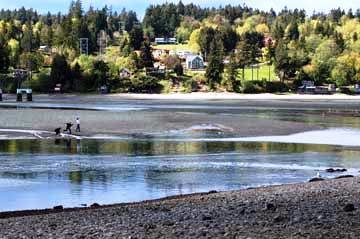[et_pb_text admin_label="Chris Fitzgerald byline; remember to tag post as various-contributors" saved_tabs="all" background_layout="light" text_orientation="left" header_font="Arimo||||" text_font="||on||" use_border_color="off" border_color="#ffffff" border_style="solid"]
The recent increase in applications for commercial aquaculture along Key Peninsula shorelines has prompted waterfront owners, and users of public shorelines alike, to ask for clarification — whose tidelands are these, anyway? It’s not always clear. If private waterfront owners have a recorded document that says the tidelands are theirs, they may be right (and protected from waking up some morning to the sound of crews installing shellfish beds) — but not necessarily, depending on which class of tidelands the deed refers to. It’s an extremely complicated subject, and weight rests with the private landowner to prove ownership in accordance with Department of Natural Resources records. Tideland leases, and the revenues received at harvest, are a multi-million dollar income source for the state.
 Looking across from Purdy Spit, the seaward logs below embankments on the opposite beach may or may not be on the original meander line. Are the children playing on tidelands, or original beachfront? If the baybed was dredged to build the bridge footings, who knows? Photo by Mindi LaRose
Looking across from Purdy Spit, the seaward logs below embankments on the opposite beach may or may not be on the original meander line. Are the children playing on tidelands, or original beachfront? If the baybed was dredged to build the bridge footings, who knows? Photo by Mindi LaRose
Originally, when Washington adopted a state Constitution on Nov. 11, 1889, all tidelands were publicly owned, as the new state claimed its right of ownership of the beds and shores of navigable waters up to and including the line of ordinary high water (mean high water). This soon became problematic because Washington is not a riparian-rights state. (If the tidelands are not owned, no aquatic industry may be pursued upon them, even if the uplands are privately owned.) The first legislative session of the new state authorized the sale of public tidelands, both to facilitate the already-established marine industries, and to provide revenue for government coffers. Until 1969, approximately 60 percent of state-owned tidelands were sold to private owners.
All shorelines were originally surveyed. This survey is called the meander line, and in some places today, with all the change that has taken place over more than a century, the meander line along some shores may actually be well away from “dry land.” What this means is that, if someone inherits an acre of uplands and the shoreline has shifted dramatically, what that person may have, in all actuality, is “an acre of water” with perhaps no access to it from the upland, because the meander line is now somewhere in the middle of a bay. (Some privately-owned boat moorings have evolved as a result of this involuntary shift in ownership from dry land to a spot on the surface of the water.) This survey, as opposed to a constant elevation line, makes it difficult to determine exactly where public and private lands meet, where shore and tidelands are concerned.
Tidelands are the shores of navigable tidal waters lying between the line or ordinary high tide and the line of extreme low tide. Confusion about who owns what tidelands, and just exactly what constitutes the various classes of tidelands, can be clouded in rules and laws set down before statehood, changed after statehood, changed again, discontinued, and grown murky with multiple deed transfers, erosion, and natural shoreline changes over time. The long and short of tideland ownership is that tidelands with uplands patented (similar to sold) prior to statehood include ownership extending to the mean high water line or the meander line, whichever is further seaward — and both change over time. Uplands patented after that date extend to the line of mean high water, which is the average of the elevations reached by all high tides for a particular area over 18.6 years. Generally, the mean high water line falls just seaward of the line of old drift logs in the upper tideland area.
Today, 1,700 miles of saltwater tidelands, including the Pacific Coast, are owned by the state. The Washington State Parks and Recreation Commission and the Washington Department of Fish and Wildlife manage some 300 miles of tidelands, including the Pacific coastal tidelands. The remaining 1,400 miles of tidelands are referred to as “public trust lands” and are managed by DNR, including all Puget Sound publicly-owned tidelands.
UNDERWRITTEN BY THE FUND FOR NONPROFIT NEWS (NEWSMATCH) AT THE MIAMI FOUNDATION, THE ANGEL GUILD, ADVERTISERS, DONORS AND PEOPLE WHO SUPPORT INDEPENDENT, NONPROFIT LOCAL NEWS